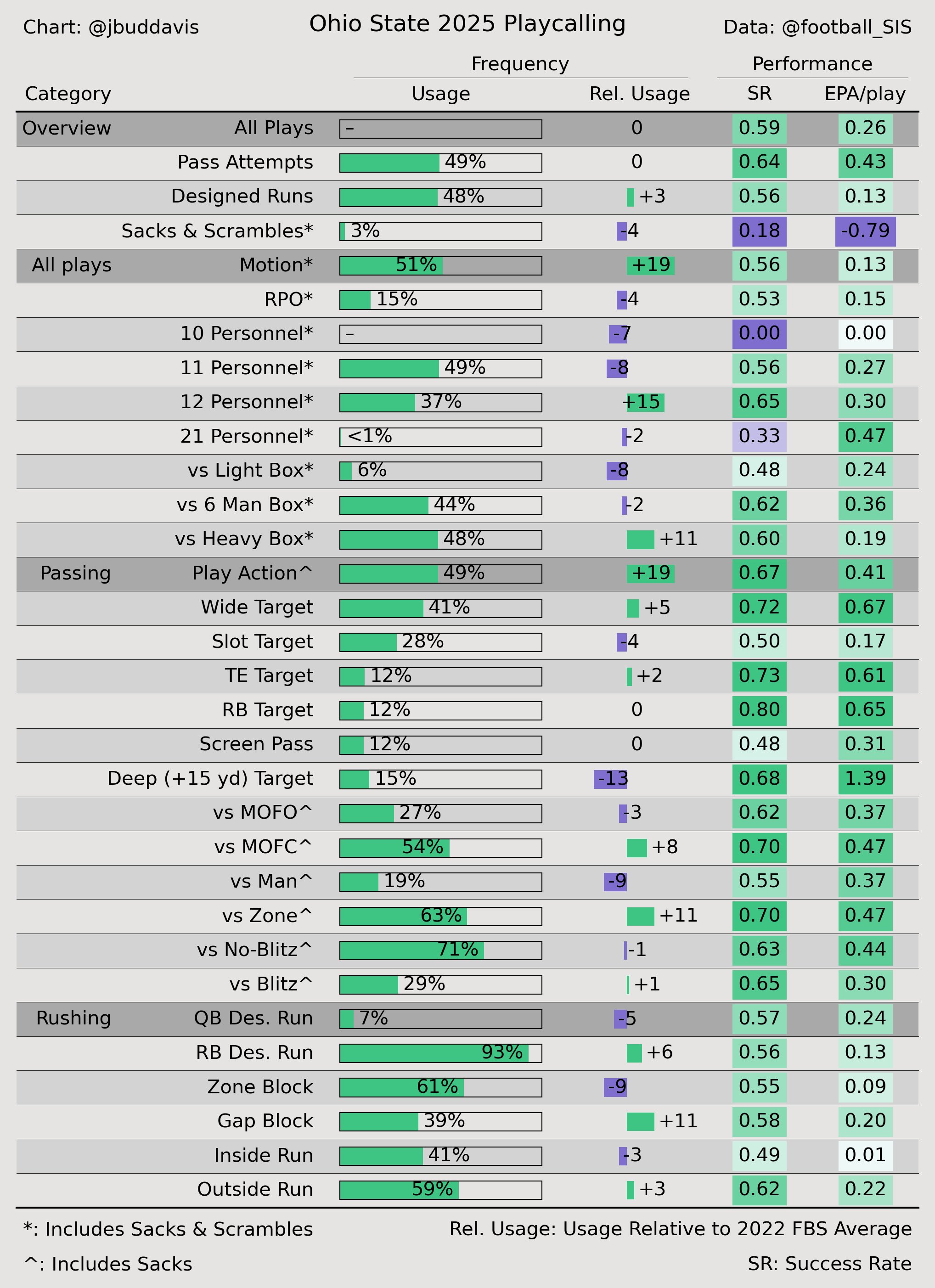I've been excited to do this film review, but was awaiting more data from Bud Davis. Bud is a stat guru and his team watches every single offensive play from the top teams, and identifies a ton of factors. Offensive personnel, zone/gap, who is targeted, what type of coverage the D is in, blitzing vs non-blitzing, etc. Essentially, his data is extremely useful in determining what defenses are doing to try and stop everything we are doing offensively. Well now we have it for the first 7 games of the season. Chart is attached, with my explanation below.

For note:
EPA/play = Expected points per play. Essentially "home-run hitting ability"
Success rate = is the play successful. For example: A 4 yard run on 1st and 10 is considered successful. Are you staying ahead of the sticks essentially.
Rel. Usage = Us versus the rest of the CFB world. From the chart, we are using gap schemes 9% more than the average of the rest of CFB. Similarly, we are facing man coverage 9% less than the rest of CFB.
MOFO = "Middle of field open" - 2 high safety shells. Cover-2/4
MOFC = "Middle of field closed" - Cover 1/3. Single safety patrolling middle of the field. Also fitting into this can be Cover-6, or Quarter-quarter-half defense. This is what Michigan plays over 50% of the time. It is their base. More on that later
Alright, now that we have the definitions, let's get rolling:
What does the data tell us about opposing defenses and their attack against us?
- Teams are stacking the box. 11% higher than national average
- Teams are running MOFC over 50% of the time against us. Single-high safety
If you take this data, and parlay it with game film, you see an obvious trend. On 1st down, teams are playing a ton of Cover-3. This is allowing them to drop and extra defender into the box to stuff the run. Once they get Ohio State behind the sticks, they transition into MOFO. I think the acronym MOFO is perfectly suited because this defense has been a "MOFO" for Ryan Day to attack at times.
In summary: The way teams think they can slow down our offense is the following:
Take away the run game. Force OSU to be willing to pass the ball a ton. Take away the deep shots by playing weak Cover-3 and Quarter zones. Win in the redzone.
That is the method. And honestly, it makes sense with the struggles we have had in the redzone and running the ball. So what can we do.
The Wisconsin game is the path. Fans noted the aggressive passing attack. However, these were not full-blown passing calls. These were all RPO's designed for Cover-3. Wisconsin chose to stay inside on every single one of these, leaving an outside WR wide open against the bailing Cover-3 corner, giving Sayin the read to pass.
While OSU moved the ball down the field at ease, the drive very nearly showed exactly why this defense is preferred. By making OSU nickel and dime their way down the field, you increase the chances of self-inflicted wounds. Those occurred when OSU had a negative rushing play, coupled with a false start. Wisconsin got exactly what they wanted. Forcing OSU into a 3rd and 11, Wisconsin switched into MOFO coverage to protect deep routes. However, with Brandon Inniss going down with an injury, OSU rotated Carnell Tate to the slot. By having an explosive WR in the slot, OSU was able to attack the weak spot of MOFO (deep down the middle).
Quarter-Quarter-Half Defense (QQH)
This coverage style is one that has really taken off in CFB over the past several seasons. Known traditionally as "Cover-6", QQH coverages aim to provide more relief to the strong side of the formation, by playing Cover-4, but sacrificing relief on the weakside, by playing Cover-2. In CFB, this works exceptionally well due to the wide hash marks, as the close boundary provides an extra layer of protection to the "soft" cover-2 side. To the wide side (cover-4), this gives the defense extra help, as most throws are designed to go in the wider area.
Another benefit of QQH defense, is that it is very easy to disguise. Let's assume you start in a base alignment with 2 deep safeties. Let's look at how easy it is to move into multiple coverages:
- 1 safety rolls down, other rotates to middle = Cover-3
- Both safeties stay home = Cover-2/4
- One Safety rotates closer to the field side = QQH
These quick and easy post-snap adjustments, paired with a defensive line that can create a pass-rush, can lead to a confused QB that doesn't have time to read the rotating defense. This is how Michigan has caused us issues recently. In this game, as OSU continued to attack the traditional Cover-3 through the air, Wisconsin began shifting to QQH defense in hopes of similar results.
How can OSU attack it
As with any defense, there are holes to try and exploit. However, one of the biggest game wreckers of QQH is an athletic TE that can stretch the field vertically. Why? Because the free safeties 1st rule is to cover any vertical route over the seam. However, he also has the responsibility of providing relief to the corner, if WR1 runs an intermediate route over the middle. The play below shows an example of OSU attacking this defense against Wisconsin. Here, OSU runs "Y-pop". This is an RPO where the QB is reading the Middle LB. If he plays pass, hand it off. If he plays run, hit the seam right over his head. I am showing the replay, because you can see it better from behind the play.
Here, the defense is playing Cover-2 to the boundary side (where Tate is), and Cover-4 to the wide side. You can't see it, but JJ Smith is lined wide to the left. To the Cover-2 side, that safety can't move because he has to cover Tate vertically. The safety to the Cover-4 side has to split the difference between Smith and Klare, in case Smith breaks his route off inside. This opens a split second window off the read for Sayin. Now in this play, Sayin doesn't take the shot, but the brief window was there to Klare.
In summary, the reason having an explosive TE wreaks havoc on QQH, is because the boundary side safety is no help, as he HAS to stay home as he is responsible for a vertical route by the WR, as part of his Cover-2 coverage. This puts the other safety in a conflict. Give help to the corner covering JJ Smith 1-on-1? Or sink back towards the middle.
Along with targeting the TE, you can also use the TE to generate deep shots. In this play, the CB at the top lined up with Graham is in Cover-2, meaning his safety has vertical responsibility. By sending the TE on another seam route, this covers up the other safety, giving JJ Smith a 1-on-1. Pass is incomplete, but you will take this more times than not.
Now, let's talk about running the ball. I highly recommend checking out Kyle Jones video for the week, as I just watched it myself to make sure I didn't copy anything he's already said. In his video, he notes the execution errors, but also how Wisconsin was forced to start playing more soft, due due to OSU passing the ball at will. Essentially, we saw a lot more Cover-3 early in the game, and more QQH later in the game.
When running the ball against QQH, there are 2 general options. 1, which is something we have seen a ton, and to not great success, outside zone to the boundary. And 2, inside runs leading towards the field side. Outside zone, in theory, should work to the boundary because there is simply 1 less defender. This is why we've seen OSU try this sooo many times throughout the years. The problem is, if you O-line can't seal the edge, the out of bounds line becomes another defender. So now let's talk about inside running that shields towards the field side. This is something we saw OSU do throughout the Wisconsin game, especially later in the game once the pass started to open things up.
The reason this play can be successful is because the safety to the Cover-4 side has a run fit. It is his job to protect the C-gap, and essentially keep a run for a gain of 5-6, instead of longer. In this play, the safety #29, is extremely late reading the run, likely due to getting burnt all game.
With that being said, sometimes running the ball is straight up just about dropping your nuts, as Donovan Jackson would say. In the 2nd half, we saw a combination of 2 things. 1, the execution got better. 2, as I said above, Wisconsin began committing more defenders to the pass.
This play below is nothing special, yet it is critical to OSU's success. With 7 blockers (out of 12 personnel), Wisconsin chose to commit just 7 defenders. You HAVE to win these situations and generate a run game. In this play they do, as Josh Padilla, Phillip Daniels, and Bennett Christian get a tremendous push.
More of the same on this play. Nice double team handoff between Hinzman and Padilla.
Nothing special. Just doing what needs to be done. If a team is committing to taking away the pass, we need to be able to run it, just like we did later in this game.
Michigan Preview
I will do a more in-depth look at Michigan later, but as a short preview a lot of what you saw in this study will apply to Michigan. Over the past few seasons, Michigan has played a ton of QQH against OSU to allow the likes of Marv and JJ to get bracketed on the field side. Remains to be seen how they attack this year. One thing though is for certain. If Michigan does in fact try and run QQH, OSU should be better prepared to attack it with the likes of Max Klare stressing the middle of the field.
Moving forward, I believe it is imperative that Josh Padilla becomes the starting RG. We were able to see in the clips above how much more effective OSU's running game was with him in the game. That being said, Wisconsin was also forced to abandon their early strategy of loading the box. Stressing the defense early with RPO's should force the defense into adjustments moving forward.
We also saw in these clips that even if defenses move to QQH defenses, there are still ways for Ohio State to attack downfield, with a large part of that being the versatility of Max Klare.
